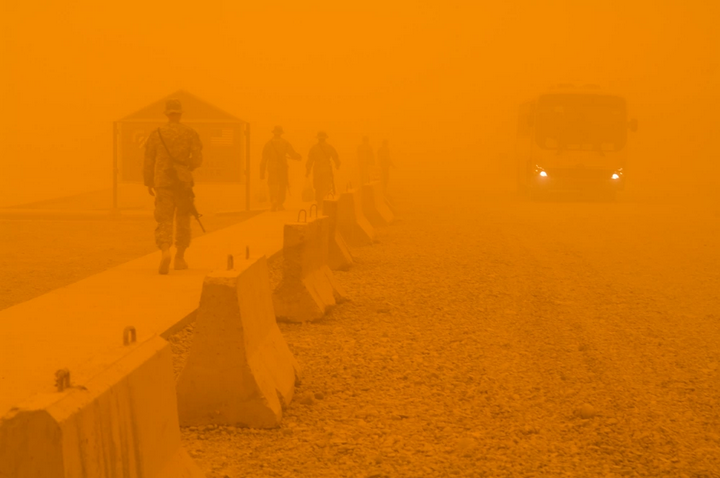
U.S. Soldiers walk from the dining facility during a sandstorm at Forward Operating Base Warhorse, Iraq, July 4 (2009).
“…the number of dusty days increased from 243 days to 272 days per year over the past two decades, and is expected to reach 300 dusty days per year in 2050.”
Over a three-week span in April and May, the Iraqi news agency Shafaq News reported at least three separate attacks in which ISIS fighters took advantage of dust storms to attack Iraqi positions. The attacks themselves are not novel, as ISIS and other rebel groups have used dust storms and sandstorms to conceal their movements during attacks in both Syria and Iraq for years. Nor were the attacks particularly impactful, relegated to brief reports in local media. The frequency and breadth of this year’s dust storms, however, have drawn substantial media attention. As detailed in the accompanying excerpt from the influential Qatari outlet al-Jazeera, the number of annual “dusty days” is expected to reach 300 by the year 2050, up from 243 at the start of the millennium and 272 at present. A major reason for this is Iraq’s accumulating environmental problems, which include ongoing drought, expanding desertification, extreme summer heat, and decreased water flows in the Tigris and Euphrates Rivers. Iraq’s dysfunctional political parties are unlikely to muster sustainable responses to these challenges, allowing the spiraling cycle to continue. Those frustrated at the negative social impacts caused by environmental degradation are likely to channel this against authorities, giving ISIS and other insurgent groups an opening to continue recruiting among the increasingly disaffected population.
Sources:
“بالتزامن مع عاصفة ترابية.. داعش يهاجم الجيش في الموصل والحشد يدخل الإنذار
(ISIS attacks the army in Mosul during dust storm, as PMF goes on alert),” Shafaq News (Iraqi news agency), 6 April 2022. https://tinyurl.com/yck9dbmy
On Wednesday, ISIS militants attacked Iraqi army units in the city of Mosul, the center of Nineveh Governorate. A statement of the 44th Brigade in the Popular Mobilization (Ansar al-Marja’iya) stated that… “a very dense dust storm hit the city of Mosul at the time of the attack by ISIS.”
Source:
“جرحى بهجوم لداعش في الانبار مستغلا عاصفة ترابية تضرب المحافظة
(Injuries in ISIS attack in Anbar taking advantage of dust storm in the province),” Shafaq News (Iraqi news agency), 19 April 2022. https://tinyurl.com/2p8wz9xa
Imad Al-Dulaimi, the mayor of Al-Rutba district, western Iraq, revealed on Tuesday that six soldiers and civilians were wounded by ISIS militants who took advantage of a dust storm that hit the area.
Source:
“مسؤول حكومي: هجوم “البو طراز” خارج حدود ديالى وداعش استغل العاصفة
(Government official: Albu Tiraz attack outside of Diyala’s borders, as ISIS takes advantage of storm),” Shafaq News (Iraqi news agency), 2 May 2022. https://tinyurl.com/yndch5bj
Eyewitnesses in the village of Albu Tiraz revealed that ISIS militants took advantage of the dust storm and lack of vision to carry out the attack, as visibility did not exceed 10 meters.
Source:
“العواصف الترابية تضرب مدن وقرى العراق طوال السنة.. تعرف على الأسباب
(Reasons why dust storms hit Iraqi cities and villages throughout the year),” al-Jazeera (influential Qatari news outlet), 19 April 2022. https://tinyurl.com/p793253f
…according to the statistics recorded by the General Meteorological Authority, the number of dusty days increased from 243 days to 272 days per year over the past two decades, and is expected to reach 300 dusty days per year in 2050. About 70% of agricultural land in Iraq is degraded or threatened with deterioration, as a result of climate change and the loss of vegetation cover, which is the main factor for soil stabilization…
Image Information:
Image: U.S. Soldiers walk from the dining facility during a sandstorm at Forward Operating Base Warhorse, Iraq, July 4 (2009).
Source: https://www.dvidshub.net/image/186799/sandstorm
Attribution: Public Domain
